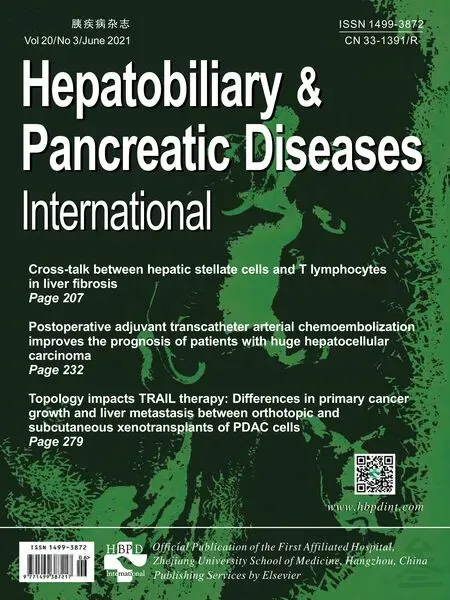Robotic choledochoduodenostomy for complicated common bile duct stones - a video vignette
Francesco Guerra ,Filippo Petrelli,Alberto Patriti
Division of Surgery - Ospedali Riuniti Marche Nord, Piazzale Cinelli 3, 61121 Pesaro, Italy
Despite that endoscopic retrograde cholangiopancreatography(ERCP) has become the gold standard in the treatment of benign biliary obstruction,bilioenteric anastomosis still represents a valid option to treat the increasing number of patients with recalcitrant obstruction,and/or altered anatomy after digestive surgery [ 1,2 ].Minimally invasive techniques have become the standard of care for the surgery of the biliary tract in specialized centers [ 2,3 ].In recent years robotic platforms have shown promising results overcoming some of the technical difficulties of conventional laparoscopy,especially in the case of demanding procedures requiring complex dissection and bilioenteric reconstruction [3].
The attached video (Video S1) demonstrates our technique of side-to-side robotic choledochoduodenostomy as performed to treat a patient with a history of cholangitis,and recalcitrant choledocholithiasis following multiple failures of endoscopic management and an intraoperative finding of cholecystogastric fistula.A 73-year-old woman with a history of diabetes and hypertension presented to the surgical department with abdominal pain in the right upper quadrant and recurrent episodes of vomiting.According to her past medical history,she had multiple ERCPs for choledocholithiasis.A plan for laparoscopic cholecystectomy was made following initial endoscopic treatment,but the patient declined surgery at that time.
Upon physical examination,the abdomen appeared distended but soft,without guarding.Laboratory tests revealed increased serum total bilirubin (5.3 mg/dL) and alkaline phosphatase (107 U/L).Abdominal magnetic resonance imaging (MRI) was obtained and revealed gross biliary tree dilatation with distal stricture of the common bile duct (CBD).Signs of pneumobilia were also present.Upper gastrointestinal endoscopy did not reveal any evident abnormality.Of note,there was no apparent bile reflux although the patient reported occasional episodes of vomiting of bile-stained fluid.A plan for robotic CBD exploration and choledochoduodenostomy was made.The patient signed a procedure-specific informed consent.
A fourth generation,four-arm Da Vinci Surgical Robot (Da Vinci Xi,Intuitive Surgical,Sunnyvale,CA,USA)was employed.The patient was placed in the supine position,with the legs apart.An anti-Trendelenburg,right-side up position was given.Pneumoperitoneum was obtained using the Veress needle in the left hypochondrium.One laparoscopic assistant port and four standard robotic ports were placed as shown in Fig.1.At surgery,a cholecystogastric fistula was encountered ( Fig.2 ).Cholecystectomy and division of the fistula with the stomach was firstly performed.The duodenum was thus mobilized via the Kocher maneuver.The CBD was prepared and a longitudinal,2-cm incision was made.Stone extraction was then performed with the aid of saline irrigation.The duodenum was incised along its superior border to create a duodenotomy of length similar to that made on the CBD.A diamond-shaped anastomosis was then fashioned by approximating the ends of the duodenal incision to the midpoints of the choledochotomy.The anastomosis was thus completed by placing full-thickness,interrupted 4.0 polydioxanone sutures circumferentially.The anastomosis was viewed under standard and fluorescent light to appraise local microcirculation with extemporaneous intravenous injection of a small bolus of indocyanine green (ICG).A methylene blue-hydropneumatic test was then performed via nasogastric tube to exclude any evidence of leak.

Fig.1.Ports placement for robotic choledochoduodenostomy.The robot was docked on the right side of the patient.R1-R4: robotic ports; A: standard laparoscopic assistant port.The endoscope was installed on R2.

Fig.2.Intraoperatively,a fistula between the gallbladder (G) and the stomach (S)was encountered.
Robotic CBD exploration with choledochoduodenostomy can be considered to treat complex choledocholithiasis competently.As opposed to hepaticojejunostomy,choledochoduodenostomy is technically easier and maintains endoscopic access to the biliary tree.Moreover,in the case of subsequent functional or infectious complications,the possibility to fashion a Roux-en-Y hepaticojejunostomy is still viable [2].
Acknowledgments
None.
CRediTauthorshipcontributionstatement
FrancescoGuerra:Conceptualization,Data curation,Writing -review & editing.FilippoPetrelli:Data curation,Methodology,Writing - original draft.AlbertoPatriti:Conceptualization,Supervision,Writing - review & editing.
Funding
None.
Ethicalapproval
Permission for publication has been received from the patient.
Competinginterest
No benefits in any form have been received or will be received from a commercial party related directly or indirectly to the subject of this article.
Supplementarymaterials
Supplementary material associated with this article can be found,in the online version,at doi:10.1016/j.hbpd.2020.12.011.
 Hepatobiliary & Pancreatic Diseases International2021年3期
Hepatobiliary & Pancreatic Diseases International2021年3期
- Hepatobiliary & Pancreatic Diseases International的其它文章
- MEETINGS AND COURSES
- Reply to: Contrast-enhanced ultrasonography for intrahepatic cholangiocarcinoma: A cost-effective alternative for low-resource settings
- Contrast-enhanced ultrasonography for intrahepatic cholangiocarcinoma: A cost-effective alternative for low-resource settings
- Transarterial chemoembolization as adjuvant treatment after surgery:The cure of huge hepatocellular carcinoma?
- RELEVANT CONTENT
- Variations of the hilar biliary confluence from postoperative cholangiography in Chinese population
